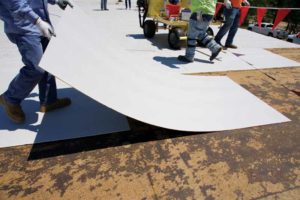High-density polyiso cover boards
Benefits of HD polyiso cover boards

Photo courtesy Johns Manville
High-density polyiso cover boards are increasingly being used as they offer many benefits.
Lightweight
HD polyiso cover boards, on average, weigh 66 to 80 per cent less than gypsum and cement products with the same thickness. Individual boards are light enough to be carried by a single worker, thereby reducing manpower requirements.
Water resistance
The water absorption by volume of HD polyiso cover boards is about four per cent, lower than traditional options such as gypsum cover boards. Polyiso boards do not rot or dissolve and can maintain their integrity under adverse weather conditions.
Fewer truckloads
HD polyiso cover boards can be shipped with about three times more square foot per truckload requiring fewer trucks/hauls, leading to fuel and transportation savings as well as reduced traffic congestion on jobsites.
Reduced product staging time
These cover boards require less crane time with lower hoisting, loading, and staging costs. They are easier to carry and move around the roof. Pallets do not require breaking or redistribution as needed with the heavier cover board product types.
Ease of cutting
Unlike gypsum or cement cover boards that require heavy-duty saws or cutters to resize, HD polyiso product types can be easily scored and cut using a utility knife. A single worker can measure and cut boards to size, increasing the roofing team’s overall productivity.
Greater resistance to heat flow
Certain cover board products can enhance building energy efficiency by increasing the overall performance of roof assemblies. For example, HD polyiso cover boards contribute additional thermal resistance to the roof assembly and can provide as much as five times greater R-value than gypsum-based products of the same thickness. A 13-mm (½-in.) HD polyiso cover board typically has an RSI value of 0.44 (2.5 R-value), whereas the RSI value of a gypsum cover board with the same thickness is about 0.11 and a cement cover board has an RSI value of about 0.07.
Dust free
HD polyiso cover boards are made of the same polyisocyanurate found in many insulation products and do not generate the dust produced by gypsum or cement products during cutting. The use of HD polyiso cover boards decreases jobsite dust and debris as well as potential for seam contamination during installation of the roof covering. Less mess equals better productivity for installers while the absence of silica particles in the air enhances worker safety.
Mould
These cover boards resist mould growth when tested in accordance with industry standards such as ASTM D3273, Standard Test Method for Resistance to Growth of Mold on the Surface of Interior Coatings in an Environmental Chamber.
Resiliency
Higher compressive strength and flexibility in HD polyiso cover boards with coated glass mat facers (CGF) improve a roof’s resistance to wind uplift and imparts greater resistance to impact from hail, as well as various construction and service activities (i.e. damage from foot traffic, heavily loaded carts, and construction tools).
Versatility
High-density polyiso cover boards can be used in new construction, reroofing, and recover applications. They are suitable in mechanically attached, adhered, and ballasted roof assemblies. HD polyiso cover boards are manufactured using the same process as polyiso board insulation. However, cover boards are produced to have a higher density, thus, higher physical properties such as compressive, flexural, and tensile strength. The product is typically produced in 13-mm (½-in.) thick boards using a continuous manufacturing process. The final product can then be cut and delivered to the jobsite in either 1.2 x 1.2 m (4 x 4 ft) or 1.2 x 2.4 m (4 x 8 ft) board sizes.


